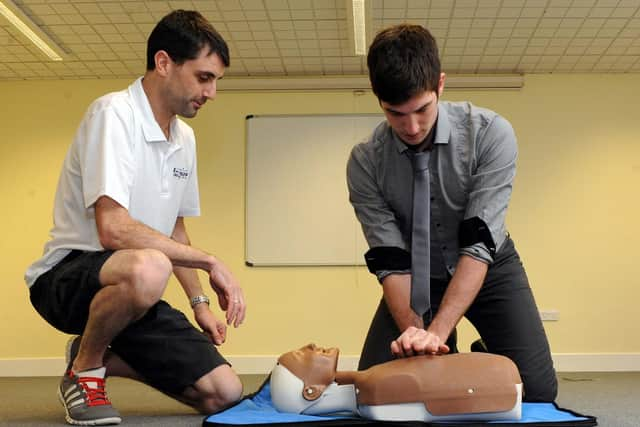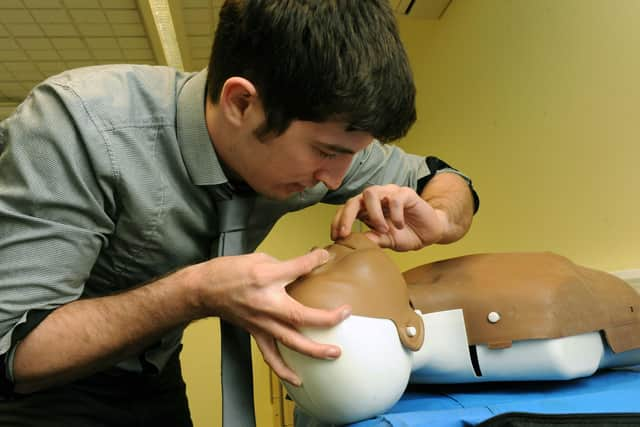First aid: This is what to do if somebody collapses and is not breathing
and live on Freeview channel 276
Yet a study by the British Red Cross revealed that only five per cent of adults have the skills and confidence to provide first aid in an emergency situation.
Now The News’s defence correspondent Tom Cotterill, a trained first aider, reveals just how simple first aid can be, and how much of a massive difference it can make in a crisis.


Advertisement
Hide AdAdvertisement
Hide Ad‘I’ve only ever had to use my first aid skills once,’ said Tom. ‘I was covering a memorial service with my old paper in Littlehampton when a 90-year-old woman collapsed to the floor.
‘She wasn’t breathing and was in a critical situation. She would have died if action wasn’t taken.
‘It was incredibly lucky that, by chance, she was surrounded not just by myself but by a team of first-aiders, including a former paramedic and a nurse.
‘Within seconds, this group of strangers was working as a team to give her CPR, taking it in turns to provide chest compressions and rescue breaths.


Advertisement
Hide AdAdvertisement
Hide Ad‘Miraculously she came to after several worrying minutes of uncertainty and later made a full recovery in hospital.
‘But had it not been for the quick reactions of all the first-aiders around her, this might not have been the case.’
What are the first step to helping someone who has collapsed and isn’t breathing?
The first step is always to make sure it is safe to approach the casualty.
Advertisement
Hide AdAdvertisement
Hide AdIf it is, check for a response – call out to them and asking them a question, or lightly tapping them on the shoulders, for instance.
If there is no response, check to see if the person is breathing by kneeling down beside them and looking to see if their chest rises and falls.
If the casualty is unconscious and isn’t breathing call 999 immediately and shout out for help.
Now it is time to begin CPR.
How do you do CPR?
First make sure the casualty is lying on their back on a flat, stable surface.
Advertisement
Hide AdAdvertisement
Hide AdFrom here look to gently tilt the head back, by placing two fingers on the forehead and under the chin. The goal is to lift the chin up to open the airways.
Using one hand, place it in the centre of the casualty’s chest, palm down, Place your other hand on top and interlock the fingers.
Now leaning over the casualty, keeping your arms straight, press down vertically on the breastbone to depress the chest by about 5-6cm (roughly two-and-a-half inches).
Release the pressure, making sure not to remove your hands, and then repeat.
Advertisement
Hide AdAdvertisement
Hide AdHow fast should my chest compressions be and how many do I do?
Ideally, you are looking to for a pace of between 100 to 120 beats per minute (think about the rhythm of the Bee Gees’ song Stayin’ Alive, if you’re not sure).
You would look to do 30 compressions at this speed.
Do I need to give the kiss of life? If so, when?
Thoughts about providing a rescue breath – or the kiss of life – have changed.
Most modern first aid courses say it is not as important as chest compressions, with some advising not to do it.
Advertisement
Hide AdAdvertisement
Hide AdHowever, you can choose to provide rescue breaths. If you do, you will give two after after each block of 30 chest compressions.
To do so for an adult (or older child), first ensure the head is tilted back and chin is up.
Pinch the nose and allow the casualty's mouth to fall open. Place your lips around the person's mouth, forming a tight seal, a blow steadily until the casualty’s chest begins to rise.
A complete rescue breath should take about a second. Repeat once more before returning to chest compressions and repeating the process until help arrives.
Advertisement
Hide AdAdvertisement
Hide AdIf in doubt, emergency call handlers will be able to walk you through the process of providing CPR over the phone.
Where can I learn more about first aid?
There are many courses available – although the coronavirus pandemic may have disrupted some of these.
The Society of St John runs a variety of courses across the Portsmouth area.
To find out more, visit the charity’s website.
The British Red Cross also has a first aid app, which can be downloaded on to a smartphone of tablet.
Comment Guidelines
National World encourages reader discussion on our stories. User feedback, insights and back-and-forth exchanges add a rich layer of context to reporting. Please review our Community Guidelines before commenting.
